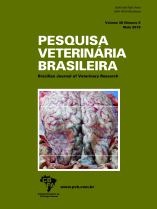 |
|
|
|
Year 2018 - Volume 38, Number 5
|

|
Clinical and epidemiological aspects and diagnosis of Trypanosoma vivax infection in a cattle herd, state of Maranhão, Brazil, 38(5):896-901
|
ABSTRACT.- Pereira H.D., Simões S.V.D., Souza F.A.L., Silveira J.A.G., Ribeiro M.F.B., Cadioli F.A. & Sampaio P.H. 2018. [Clinical and epidemiological aspects and diagnosis of Trypanosoma vivax infection in a cattle herd, state of Maranhão, Brazil.] Aspectos clínicos, epidemiológicos e diagnóstico da infecção por Trypanosoma vivax em rebanho bovino no estado do Maranhão. Pesquisa Veterinária Brasileira 38(5):896-901. Departamento de Ciências Veterinárias, Centro de Ciências Agrárias, Universidade Federal da Paraíba, Rodovia PB-079, Areia, PB 58397-000, Brazil. E-mail: saravdsimoes@gmail.com
The objective of this study was to investigate the occurrence of trypanosomiasis in a dairy farm in municipality of Timon, State of Maranhão, Brazil. The owner reported abortus, births of weak calves, and mortality of adult animals with progressive weight loss. Visits to the property were carried out to obtain the history, realize animal examination and blood collection for the Woo test, hemograms, serological tests for trypanosomiasis, leptospirosis, and neosporosis and PCR for molecular diagnosis of Trypanosoma vivax. The identification of animals with low values in the hematocrit was the main hematological alteration identified in the herd. Two animals were positive in the Woo test and trypanosomes were visualized in blood smears, confirmed by molecular diagnosis as T. vivax. It was identified that 95.23% (40/42) of the animals with low hematocrit were serologically positive for T. vivax. The conditions identified in the property as an environment propitious to mechanical vectors, the presence of wild animals and the introduction of animals from states where trypanosomiasis outbreaks had already been reported were probably associated with the introduction and dissemination of the agent in the herd. The high number of serologically positive animals for trypanosomiasis 82.51% (151/183) shows that almost all the herd had contact with the agent. The rapid establishment of control measures, including the use of trypanocidal drugs, contributed to the control of the outbreak. The study allowed confirming the occurrence of another outbreak of trypanosomiasis in Brazil. The clinical diagnosis of the disease was difficult by the similarity of the clinical signs of trypanosomiasis with other diseases and the possibility of association of two or more diseases in the same patient, which emphasizes the importance of establishing adequate diagnostic measures as a way to avoid the dissemination of the disease and to minimize the economic losses of the producers. |
| |
|
|
| |
|
 |